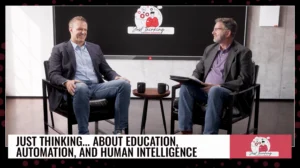When we posted our 2020 predictions on January 1 last year, we–along with the majority of the world–definitely didn’t anticipate the curveball that was (and continues to be) the global COVID-19 pandemic.
2020 has been called a dumpster fire, the worst year in recent memory, and more. While online learning was already growing in popularity in higher education, the nation’s abrupt shift to virtual and hybrid learning laid bare the vast inequities and hurdles that exist in the U.S. education system.
The mass move to online learning also made people wonder: Are there practices we can continue when the pandemic abates? What can we take from this when we return to our campuses? And will we return to our classrooms to teach in the same manner as we did before COVID?
We asked edtech executives, stakeholders, and experts to share some of their thoughts and predictions about where they think higher-ed edtech is headed in 2021.
Here’s what they had to say:
College students in 2020 and 2021 will experience college in a way no other classes have, and they’ll likely also face unique challenges in the next few months and years as they enter the workforce. COVID-19 has created the perfect storm of obstacles for college students – fewer opportunities to network, disruption to hands-on learning and fewer companies hiring entry-level positions – and they’ll need to rely on technology to overcome the risk of a skills gap. In 2021, college students must lean on their technology experience and participate in virtual career fairs and networking events to form the connections that will help them navigate an unprecedented job market.
– Ed Barrientos, CEO, Brazen
Chatbots will be critical to student engagement. While online education isn’t a new trend, it saw a vast acceleration because of the COVID-19 pandemic–and it is not going away anytime soon. Teaching remotely brings unique challenges for teachers and students, but successful remote teaching models find ways to leverage technology to improve student outcomes. Post COVID-19, education institutions will have to adjust to the “new normal”–one that is not 100% remote or 100% analog, but one that takes the best of both worlds to deliver a superior education experience for students. In the 2021 landscape, schools will rely on technology like chatbots and automation more than ever. Once implemented, these tools will help institutions improve teaching models, produce better outcomes for students, and ultimately reduce the cost of servicing and teaching students.
– Brad Benz, Managing Director , Benz Capital, and Education Advisor, Capacity
The most successful tools in 2021 and for a post-pandemic future will be the ones that deliver real outcomes in terms of better and more effective learning, the ability to bridge the gap between online and classroom teaching, or the capacity for cost-savings at the same quality. There will be more focus on achieving learning for the students and less on ‘delivering education.’ This change has already happened and will accelerate. Another change is that more and more textbook resources will be free in the future, and we will pay only for tools that really improve learning outcomes.
– Mads Bonde, Co-Founder, Labster
Cloud first technology strategies will become an even greater priority for colleges and universities. COVID-19 will accelerate this transition as institutions need to manage their operating expenses, prioritize spending to improve the student experience, and deem self-hosting too expensive. Traditionally, data science and analysis initiatives have focused on leveraging enrollment and student success data to improve outcomes and grow revenues. Now, institutions will apply the same techniques to mine their financial and operational data to rationalize their cost structures as they counter budget deficits. Tech spend will be reprioritized. Very large technology projects, such as replacing the Student Information System or Learning Management System, will be delayed as institutions try to squeeze extra life out of legacy applications but smaller, high value projects deemed essential to learning delivery, strategic planning, and managing university operations will grab wallet share.
– Darren Catalano, CEO, HelioCampus, and former VP of Analytics, the University of Maryland Global Campus
Micro-credentialing will gain even more traction in 2021. Students need faster, affordable and flexible higher-ed options they can turn around and immediately use in the workplace as alternatives to traditional 4-year degree programs. Big tech including Google and Amazon are now offering credentialing programs, and we expect to see even more players join us in this fast-growing space. Second, universities will cater more to adult learners. Colleges will broaden their focus beyond traditional-age students (ages 18-21) and focus on meeting students’ needs along a continuum. This includes adult learners going back to school to finish degrees or enroll in short-term programs that result in employable skills. Universities will beef up their workforce education programs in response to demand.
– Andrew Clark, CEO, Zovio
School administrators will be held to a higher level of accountability and transparency. In 2021, administrators will finally begin to see how digital transformation can help facilitate communications between departments, and reduce the time and cost of performing essential services for their students. The remote work environment has provided schools with the ability to build a digital infrastructure that monitors staff productivity without seeing them physically to eliminate bottlenecks and help staff when they encounter any issue, even without being in the same building. If this is done right, schools will start to build a culture of great trust and higher transparency and accountability.
– Linda Ding, Director of Strategic Marketing, Laserfiche
In 2021, we can expect to see education software providers accelerate the integration of payments into their platforms. Even with the likely deployment of COVID vaccines starting early next year, we’re still a ways off from ‘back to normal,’ and educational institutions will need to streamline their processes for collecting and processing card and ACH payments remotely, for services ranging from tuition and fees to charitable donations. Parents and students have increasingly demanded the ease and efficiency that digital payments offer, while school administrators need the capabilities to simplify their student management and accounting. Education software solutions, which provide ease of payment acceptance and simplify back-office tasks, have solidified the need for integrated payments technology in the education space.
– Mark Engels, Chief Revenue Officer, Paya
“We learned in 2020 that the “new normal” for educational facilities will need to look a lot different than the normal we’re used to. Safely getting back to the classroom requires many new precautions, and in 2021, innovations in technology such as digital signage software and content management will play a major role. From signage that presents important updates about social distancing to touchless accessibility of information through mobile access control, to temperature screening at building entrances to ensure peace of mind, more schools will be implementing technologies that will help students, faculty, and families best navigate the post-COVID classroom. Leveraging digital signage and content management platforms will be a tool in supporting schools in doing what they do best: putting education first.”
–Kathy Isaacs, Regional Manager, 22Miles
In 2021, two-year institutions will experience an increase in enrollment. Although these institutions are currently looking at a 7.5% drop in undergraduate attendance, in the past, economic downturns have coincided with an increased interest in higher education, as students look to maximize their free time in a productive fashion. Going into 2021 with a larger influx of students and limited staff, institutions will seek digital solutions for student services assistance for retention, keeping students engaged and giving back time for faculty members to focus on student success. Most institutions don’t have the success tools in place that allow for a large scale-up in students. By implementing digital solutions, universities can better manage student engagement and retention.”
– Alex Leader, CEO, Aviso Retention
Higher ed will build a more effective, robust online learning experience. Higher Education has been a leader in online learning, and the pandemic provided the opportunity to adapt and evolve that model at scale in a way that will have a lasting impact. Effective online learning is about more than posting assignments and Zoom lectures. As higher education institutions prepare for 2021, we will see an investment in technology, training, and flexible curriculum that combines traditional classroom outcomes with certificates, stackable credentials and digital badges that will help educators reach students in new, exciting ways.
– Susan Manning, Chief Success Strategist, Credly
“Increased demand for both awareness and skill building programs will help drive technology development and subsequent commercial proliferation. I anticipate an increasing demand for workshops and seminars that showcase the range of benefits the technology enables in diverse application spaces, as FHE technology continues to mature and demonstrate its potential to transform advanced manufactured products. We expect to see more defense and industrial demand for engineers with the knowledge, skills, and abilities to design and manufacture FHE-enabled products as the technology nears commercialization.”
– Emily McGrath, Workforce Development Director, NextFlex
Remote student recruitment will become the new normal. Thousands of institutions depended on travel to recruit students. With this on hold, they have had to transition quickly to online recruiting channels. This shift to remote recruiting has exposed the enormous inefficiency of traditional in-person recruiting, which is slow, expensive, difficult to measure, and hard on the environment. Universities are getting the best results by streamlining their admission processes and integrating them directly into the student recruitment process, to create a friendlier, more accessible experience for students. Expect a boom in new solutions to this problem as technology companies drive universities to integrate their internal departments more effectively. The future is student-centric!
– Joe Morrison, CEO, Concourse
One bright spot in a difficult year was the increase in collaboration that we’ve seen across higher education and the willingness of institutions to help each other through course sharing. During the rapid transition to online learning in the spring and throughout an unprecedented fall semester, we saw colleges and universities come together to unlock capacity and help students access the resources and courses they needed wherever they could be found. In 2021, I expect forward-thinking institution leaders to maintain the same collaborative approach and not settle for a return to “normal” as vaccines are rolled out across the country. Higher education will continue to feel the impact of COVID-19 for years to come requiring institutions to collaborate in new ways to put students and their needs first over what limited capacity they might have locally.
– Josh Piece, CEO and Co-Founder, Acadeum
As we move to a post-pandemic era in 2021, educational institutions will continue to understand that technology-rich education environments are essential when it comes to effective learning for students both in the classroom and remote. Investment in audiovisual tools will continue to grow as higher education institutions recognize that moving forward, a larger portion of their students will be remote. Educators in K-12 and higher education environments will adapt new tools and technologies in 2021 that will make lectures and lessons engaging for students wherever they are physically located.
– Paul Richards, Director of Marketing, PTZOptics and HuddleCamHD
As we hopefully turn a corner with COVID-19 for the Fall 2021 semester, I expect that hybrid learning models will become the new normal. Institutions will embrace a portfolio of options, courses that blend in-person and online, purely in-person, live online, and recorded online instruction. While many traditionally-aged students may opt for a return to campus, the flexibility of these options will be critical for so many. Of course, this will require rethinking an institution’s digital infrastructure, instructional design, and student supports in order to enable seamless transitions between in-person and online. Institutions’ ability to achieve this seamless experience for their students will become as essential to their brands as their athletics or campus amenities. Technology companies and learning providers will need work together in more intentional ways. We’ll need to rethink how we support faculty, instructional designers, and staff. But it’s an opportunity. For years now, the traditional model has only worked for a sliver of those who need education. I’m optimistic that we’re headed into a new era of higher education that is able to deliver on its great promise.
– Fred Singer, CEO, Echo360
As institutions navigate budget reductions and increases in compliance costs as a result of the pandemic, institutions are likely to see short to midterm financial instability. Experts are already predicting that the number of institutions at risk for closure could reach double digit percentages. This instability means institutions need flexible and agile infrastructure that enables them to scale up or down as necessary, only using the resources they need at a given time. As-a-service solutions help meet this need. IT is a mission critical partner. Edtech has and will continue to help strengthen academic delivery. I hope to see a business model transformation – with institutions leveraging IT to help reduce operating costs while increasing efficiencies/performance and reallocating op-ex into research and academic operations with IT providing leadership as a trusted business partner.
– Mike Wiseman, Vice President SLED, Pure Storage
Follow us on social media for the latest updates in B2B!
Twitter – @MarketScale
Facebook – facebook.com/marketscale
LinkedIn – linkedin.com/company/marketscale








